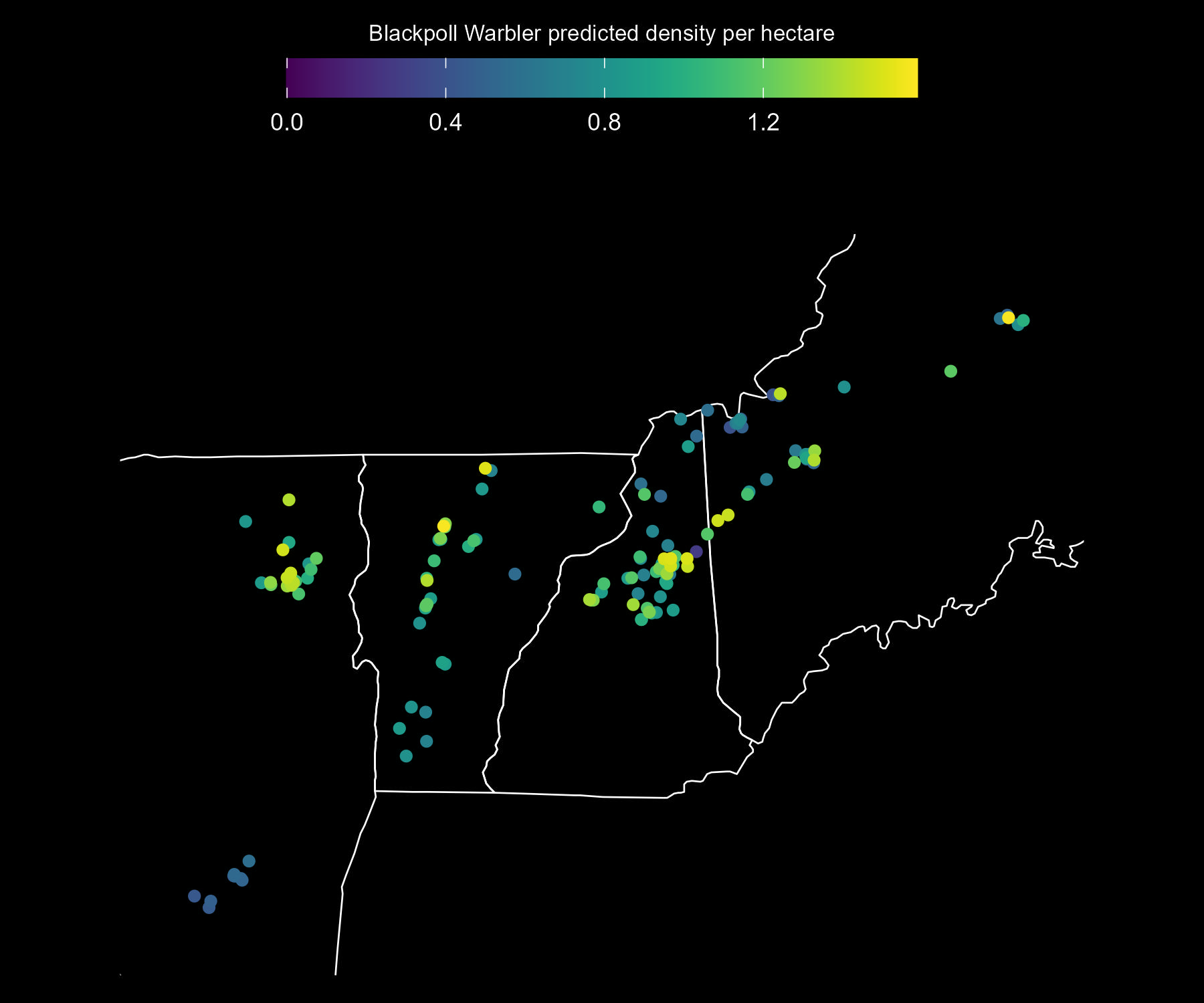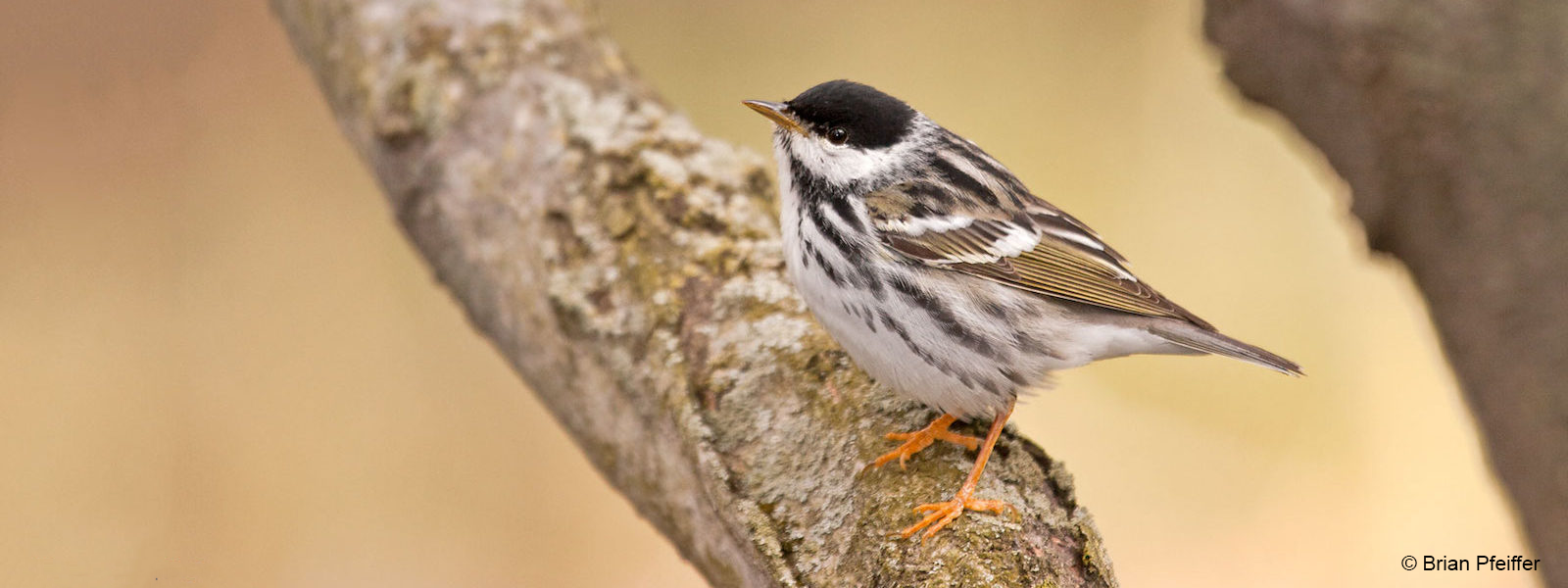The State of Blackpoll Warblers in the Northeast
Regionally: Rapid decline

The mean (thick, yellow line) annual estimate of Blackpoll Warbler abundance within the immediate area surrounding all 803 Mountain Birdwatch sampling locations, with a 95% Bayesian credible interval (blue polygon, representing estimate uncertainty).
Mountain Birdwatch data indicate a steep overall population decline (annual trend = -4.56% per year, 80% credible interval = -5.15% to -3.96%) in the mountains of our region; this trend equates to a 47.94% decline between 2010 and 2024. The steepest declines were observed in Catskills and Maine (see table below).

Predicted Blackpoll Warbler adult density per approximate hectare in an average year (between 2010 and 2024), as estimated from Mountain Birdwatch data. The base map shows the extent of the Mountain Birdwatch region: eastern New York, Vermont, New Hampshire, and western Maine.
| Region | Mean annual trend (%) | Trend 80% CRI | Probability of decrease | Probability of increase | Population change (%) 2010-2024 | Population change (80% CRI) |
|---|---|---|---|---|---|---|
| All regions | (-5.15, -3.96) | >0.99 | <0.01 | -47.94 | (-52.31, -43.18) | |
| Maine | (-7.18, -5.37) | >0.99 | <0.01 | -59.59 | (-64.75, -53.82) | |
| New Hampshire | (-4.70, -3.26) | >0.99 | <0.01 | -43.4 | (-49.06, -37.08) | |
| New York (entire region) | (-4.84, -2.80) | >0.99 | <0.01 | -42.01 | (-50.08, -32.85) | |
| New York (Adirondacks only) | (-4.67, -2.44) | >0.99 | <0.01 | -39.7 | (-48.81, -29.21) | |
| New York (Catskills only) | (-7.20, -4.40) | >0.99 | <0.01 | -56.6 | (-64.86, -46.74) | |
| Vermont | (-4.01, -2.25) | >0.99 | <0.01 | -35.94 | (-43.62, -27.29) |
Mountain Birdwatch is the only monitoring program that rigorously tracks Blackpoll Warbler populations, and it will likely play a crucial role in our understanding of this species in the northeastern United States. Blackpoll Warbler’s preference for high-elevation breeding habitat in the northeastern U.S. clearly put this species long-term existence at risk from global climate change. Under most climate change scenarios, Blackpoll Warbler ranges are predicted to move steadily northward and to disappear from New England and New York by the end of this century. Recent research (manuscript in prep) by Jason Hill suggests that Blackpoll Warbler are already responding to climate change, and that their populations in the northeastern U.S. have significantly tracked upslope by more than 50 m from 2011 to 2019. Clearly, more research is needed, and quickly, to identify effective conservation and management strategies for this species.
Globally: Declining
Overall, Blackpoll Warbler appears to have been declining for many decades across much of their breeding range. Data collected by the USGS Breeding Bird Survey indicate declines of 2-4% per year since in the number of Blackpoll Warblers counted across Canada (where most of the population lives). This species is very difficult to monitor in Canada, however, because its core breeding habitat is so remote and inaccessible. As such, confidence in these estimates is low. The Breeding Bird Survey data suggest that declines are steepest in the eastern portion of the range, while eBird trends suggest that Blackpoll Warblers are declining everywhere except the far east of their breeding range in eastern Quebec and Newfoundland and Labrador. The eBird trends for this species have large estimates of uncertainty around them, so it remains to be seen how Blackpoll Warblers are faring in the East.


